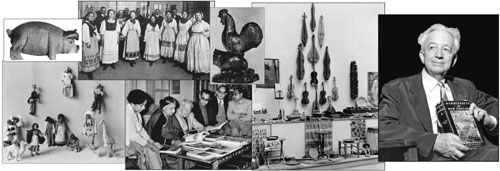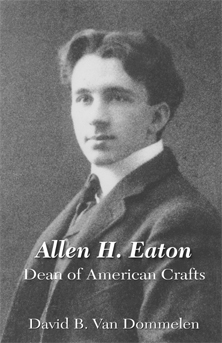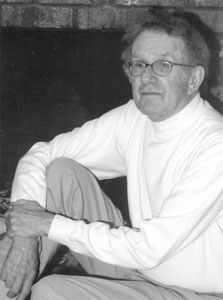Allen H. Eaton, Dean of American Crafts.
by David B. Van Dommelen.,
Professor emeritus, Penn State Univ.
List Price: $29.95, ISBN 0-9711835-9-7
|
|
The only biography of mid-20th century America's leading handicrafts advocate.
|
|
Van Dommelen. has contributed a fascinating chapter in the history of American craft with this biography of a gentle visionary who believed in the power of art to change lives, and devoted his life to pursuing social justice through 'handicraft'. Eaton's vision is still very relevant today.
Janet L. McCall, Executive Director
Society for Contemporary Craft
|
|
|
|
|
|
ISBN 0-9711835-9-7, 5.5x8.5 in., 215 pages, softcover, 26 per carton. Includes 50 photos. Subject categories include Art history, immigrants, American handicraft, local history & heritage, Eugene and Portland Oregon, Appalachia, New England, New York, 20th century American social and political history, and non-fiction.
|
|
|
 |
|
Photos: Clockwise from upper left: :Wooden pig at the Franklin Delano Library. Buffalo Arts and Crafts Exhibition from Immigrant Gifts to American Life*. Wooden rooster photo by A. Burton Carnes*. Photo from the Rural Arts Exhibition by Theodor Horydczak*. Photo of Eaton in 1955 by Edward DuPuy. Eaton in India, 1960*. Photo from the Rural Arts Exhibition photo by Theodor Horydczak*. (* Courtesy of Elizabeth and Martha Eaton.)
|
|
DESCRIPTION
Culmination of 20 years of research.
Thanks to this well researched and heartfelt biography, Allen H. Eaton (1878-1962) retakes his much-deserved place in the history of American craft. A tireless craft advocate, Eaton almost single-handedly established the relationship between art, beauty and life, a relationship not previously acknowledged or appreciated until he pointed it out. His work brought prominence and respect to handicraft produced by the people of Oregon, Southern Appalachia, New England, immigrants, the blind and even prisoners in Japanese-American internment camps. Widely know as “the Dean of American Crafts”, this is his story.
Van Dommelen. spent over twenty years researching the life of Eaton and conducting a number of in-person interviews with Eaton’s colleagues, family and friends, as he developed this first-ever biography.
Eaton influenced politics as well as art.
As a member of the Oregon legislature during the early 20th century, Eaton was a tireless advocate for the referendum system of government now such a popular feature of the western political landscape.
Does this sound familiar?
Eaton was forced out of the Oregon state legislature for bucking corporate interests in favor of public safety. He was also fired from his university faculty position, branded a traitor for associating with some who expressed dissenting political opinions during wartime. (The university eventually awarded him an honorary Doctor of Laws degree in 1938, recognizing not only its error in dismissing him but also his later achievements apart from the university.) These heartbreaking events caused Eaton and his family to leave their beloved Oregon and head east.
His Life’s work:
In New York, Eaton joined the new Russell Sage Foundation, a platform from which he launched his true life’s work, the elevation of handicrafts. His gentle demeanor, deep insights, and integrity earned him the respect of his colleagues, craftspeople, and the powerful alike. His most ironic friendship, perhaps, was with Eleanor Roosevelt who penned a foreword to one of his most controversial works, Beauty Behind Barbed Wire, a celebration of crafts in the Japanese-American internment camps (it was Franklin Roosevelt who signed the executive order creating the camps during World War II).
FROM THE BOOK:
Jerome Nathanson, eulogizing Eaton in 1962 said:
"If any human being in my experience ever enriched people’s lives, Allen did...He was a person of great courage."
By Helen Keller from the foreword to Eaton's "Beauty for the Sighted and the Blind":
"He affords an impressive, concrete realization of life that will enrich the blind and discard the remoteness which used to be their lot... Mr. Eaton will build up the delightful subjects of common interest between the blind and their seeing fellows."
From the citation for the honorary Doctor of Humane Letters from Berea College:
"Student and scholar who has found beauty in the common creations of man and interpreted the arts of mind and hand for the enrichment of life for all."
On Eaton's "Beauty Behind Barbed Wire":
"...a story without parallel in this country."
From the citation for the honorary Doctor of Law degree from the University of Oregon:
"In recognition of his foresight and courage as legislator, citizen and public servant. His tireless endeavor in promoting an appreciation of beauty and art and creative craftsmanship, and his sympathetic and enlightened understanding of the vital contributions which foreign-born citizens have made to the culture and civilization of America."
Eaton’s departure from the legislature:
"...there is little doubt that Eaton’s involvement in important policy-making legislature was deep, and there is every right to consider the fact that big industry and banking concerns would attempt to unseat him from the (Oregon) State Legislature and make him appear undesirable in his community by any method they found most convenient."
TABLE OF CONTENTS
Dedication
Acknowledgments
Introduction
1. The Early Years
2. The Russell Sage Foundation
3. Immigrant Gifts to American Life
4. Handicrafts of the Southern Highlands
5. Handicrafts of New England
6. Beauty Behind Barbed Wire
7. Beauty for the Sighted and the Blind
8. The Final Years
9. Afterword
Bibliography
The Author
Index
Colophon
About the Author
David B. Van Dommelen is professor emeritus at the Pennsylvania State University. He and his wife live in the mountains of Central Pennsylvania where he runs a private design firm.
|
|
|
|
|
|
|



